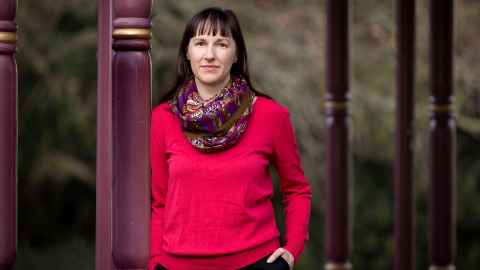Karly Burch: Whose data to believe over nuclear wastewater?
1 August 2023
Opinion: Dr Karly Burch wonders who is providing the most accurate scientific data following Japan’s decision to discharge nuclear wastewater into the Pacific Ocean.

Tokyo Electric Power Company (TEPCO) is planning to discharge 1.3 million tonnes of treated nuclear wastewater into the Pacific Ocean, beginning this year and continuing for at least 30 years.
The plan was first announced by the Japanese government in April 2021, approved by Japan’s nuclear regulator in May 2022 and approved by the United Nations’ International Atomic Energy Agency (IAEA) in July 2023.
This 1.3 million tonnes of wastewater exists because TEPCO has been using water to cool melted nuclear fuel rods within Fukushima Daiichi’s damaged nuclear energy reactors since the earthquake, tsunami and nuclear disaster of 2011.
When water is poured onto melted nuclear fuel rods, it leaves a chemical cocktail of radionuclides. Some of this wastewater has already leaked directly into the Pacific Ocean (at around 300 tonnes per day in 2013), so the 1.3 million tonnes represent the estimated amount currently being stored on land in large tanks.
TEPCO has framed its current plans to filter and discharge the wastewater as the optimal solution to its overflowing problem, and the IAEA has examined the data produced by TEPCO’s scientists and said the plan aligns with the agency’s standards.
Yet many people throughout the Pacific and Japan, including many scientists, say the plan is problematic. This includes members of an independent panel of scientists gathered by the Pacific Islands Forum to examine TEPCO’s data.
Science is always driven by research questions which come from particular people and places. Tokyo Electric’s scientists are focused on answering questions that are of importance to TEPCO and the IAEA, and therefore on collecting data that shows the wastewater discharge plan aligns with IAEA standards.
Answering these questions helps TEPCO avoid legal and financial responsibility for managing its nuclear waste on land. Unfortunately, the IAEA’s nuclear safety standards are extremely limited as they only address questions related to chemistry and external radiation dose.
The independent panel of scientists working with the Pacific Islands Forum is attempting to use the most up-to-date scientific findings to answer research questions posed by people across the Pacific. This includes questions about the possible health and environmental consequences of the nuclear wastewater release.
Voicing scientific concerns about Tokyo Electric Power Company’s data is not going to sway them or the International Atomic Energy Agency.
However, these scientists are relying on data produced by TEPCO which they have described as “incomplete, inadequate, and inconsistent”. In other words, while TEPCO’s scientific data can answer questions posed by the IAEA, it can’t answer questions posed by people in the Pacific who will be forced to deal with the consequences of the wastewater discharge.
While TEPCO is pushing for the wastewater discharge, it does have other options.
Scientists working with the Pacific Islands Forum have proposed a plan which would involve using the wastewater to create concrete that could patch up leaks and contribute to other on-site remedial work.
This is estimated to take approximately five years and would respond to recent scientific findings on the biological consequences of tritium (radioactive hydrogen) which are not currently accounted for in the IAEA’s standards.
However, Japan has so far rejected the plan since the concrete would be classified as nuclear waste under Japanese law, illustrating how the IAEA’s approval allows Japan to discharge its responsibilities for managing its own nuclear waste by using the Pacific as a dumping ground.
Unfortunately, as the scientists working with the Pacific Islands Forum have illustrated and discussed, voicing scientific concerns about Tokyo Electric’s data is not going to sway the power company or the IAEA.
This has been the case, even when the IAEA has been called out for ignoring the principles underlying its own standards, which would require TEPCO to clearly illustrate that the wastewater discharge plan’s benefits to countries other than Japan outweigh its possible harm. The fact that there are no benefits should disqualify the plan under the agency’s own standards.
In the long term, we need serious discussions about the appropriateness and reliability of the agency’s standards and how these are based on threshold limits which assume access to lands and waters as waste sinks to sustain the nuclear energy industry. We also need to examine how the standards are often used to legitimise ongoing trends in nuclear colonialism.
In the short term, it’s important to stop TEPCO’s wastewater discharge and use it as an opportunity to engage in rigorous scientific deliberation on how to responsibly manage nuclear waste without perpetuating nuclear colonialism and impeding the sovereignty and self-determination of others.
One option is for a neighbouring country to file a case against Japan before the International Tribunal for the Law of the Sea. This is an important option for New Zealand and other countries who claim to be advocates of evidence-based policies, and who are committed to protecting ocean biodiversity and a nuclear-free Pacific.
Dr Karly Burch is a lecturer in sociology at Waipapa Taumata Rau, University of Auckland. She has spent the past decade studying food safety governance in the aftermath of the Fukushima Daiichi nuclear disaster.
The views in this article are personal opinion and not necessarily those of the University of Auckland.
This article first appeared in the August 2023 edition of UniNews.